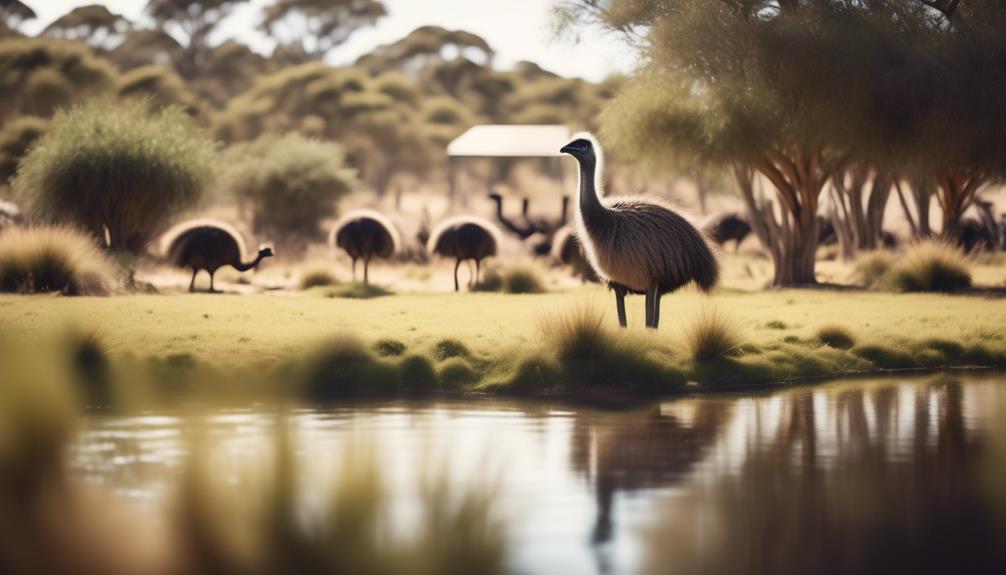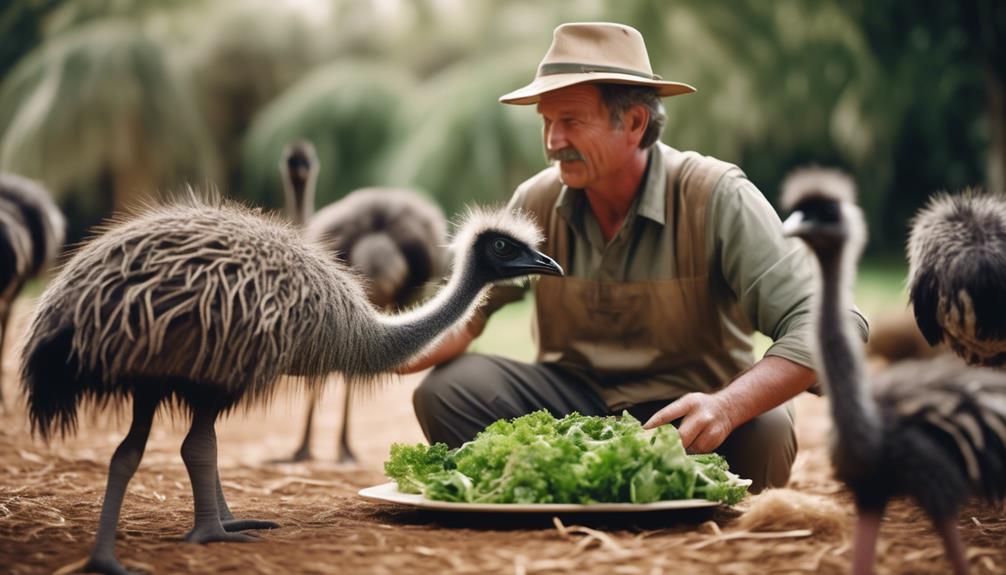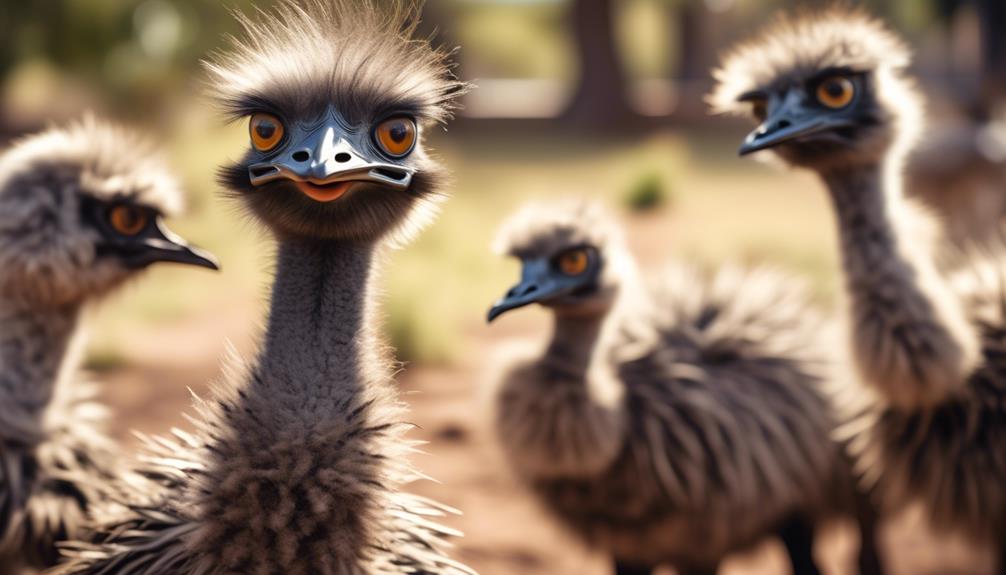
So, you've decided to venture into the world of emu farming and education. Congratulations! Emus are fascinating creatures that not only have the potential to generate income through farming but can also be valuable assets in educational programs.
But where do you start? How do you handle and train these magnificent birds effectively? In this discussion, we will explore the essential steps and guidelines for handling and training emus for farming and education, helping you lay a strong foundation for success.
Get ready to discover the secrets to unlocking the full potential of these remarkable creatures.
Emu Farming: Getting Started

To begin your emu farming journey, it's essential to carefully plan and prepare for the unique challenges and requirements of raising these fascinating flightless birds. Raising emus can be a rewarding endeavor, but it requires a deep understanding of their health and care needs.
First and foremost, providing a suitable habitat for your emus is crucial. Emus are native to Australia and thrive in open spaces with access to water. Ensure that your emu enclosure is spacious enough to allow them to roam and exercise freely. Additionally, emus are social animals, so it's recommended to keep them in pairs or small groups to promote their well-being.
Emu health is of utmost importance. Regular veterinary check-ups and vaccinations are necessary to prevent diseases and ensure optimal health. Emus require a balanced diet consisting of fruits, vegetables, grains, and protein sources such as insects or commercial emu feed.
Proper care also involves maintaining a clean and hygienic environment for your emus. Regularly clean their enclosure, provide fresh water, and ensure their bedding is dry and comfortable.
Lastly, handling emus requires patience and training. Start by gaining their trust through gentle interactions and gradually introduce them to being touched and handled. This will help minimize stress for both you and the emus.
Choosing the Right Emus for Your Farm
When selecting emus for your farm, it's crucial to consider their specific characteristics, such as age, health, and temperament, to ensure a successful and harmonious addition to your flock.
Emu selection criteria play a significant role in determining the suitability of an emu for your farm.
Firstly, consider the age of the emu. Young emus, around 6-12 months old, are generally easier to train and adapt to their new environment. Older emus may require more time and effort to acclimate to the farm's routines and practices.
Secondly, assess the overall health of the emu. Look for signs of good physical condition, such as shiny and well-groomed feathers, clear eyes, and an alert demeanor. Avoid emus with visible signs of illness or malnutrition.
Lastly, evaluate the temperament of the emu. Emu behavioral characteristics can vary, so choose emus that display calm and non-aggressive behaviors. This will contribute to a peaceful and stress-free environment for both the emus and other animals on the farm.
Creating a Suitable Habitat for Emus

As you prepare to introduce emus to your farm, it's crucial to create a suitable habitat that meets their specific needs and ensures their well-being. Designing an emu enclosure requires careful consideration of their behavioral needs.
Here are three key factors to keep in mind:
- Space: Emus are large, flightless birds that require ample space to move around and exercise. Provide at least 2500 square feet of space per pair of emus. This allows them to stretch their long legs and run freely, which is essential for their physical and mental health.
- Shelter: Emus need a sheltered area to protect them from extreme weather conditions. Construct a sturdy shelter with a solid roof and good ventilation. Ensure that it's spacious enough for the emus to comfortably move around and rest. Consider adding nesting boxes for breeding pairs.
- Fencing: Emus are curious and can be prone to escaping if not properly contained. Use a fence that's at least 6 feet high and buried at least 1 foot into the ground to prevent them from digging under it. Make sure the fence is sturdy and secure to keep predators out and emus in.
Handling and Safety Guidelines for Emu Farming
Handling emus on a farm requires strict adherence to safety guidelines to ensure the well-being of both the birds and the handlers. Emus are large, flightless birds known for their strong legs and sharp beaks, which can cause injury if not handled properly.
When approaching emus, always approach slowly and calmly, avoiding sudden movements that may startle them. It's important to keep a safe distance from the birds, as they can become aggressive if they feel threatened. Emu handling techniques involve using long poles or sticks to guide the birds gently and safely. These tools should be used to maintain a comfortable distance from the emus while still allowing for necessary interaction.
Additionally, handlers should wear protective clothing, such as gloves and closed-toe shoes, to minimize the risk of injury from scratches or bites. Emu farming safety precautions also include securely fencing the enclosures to prevent escape and ensuring that all gates and doors are properly locked.
Regular training and socialization of emus can help to minimize their stress levels and improve their overall welfare. By following these guidelines, you can ensure a safe and successful emu farming experience.
Emu Feeding and Nutrition Requirements

To ensure the health and productivity of emus on a farm, it's essential to understand their feeding and nutrition requirements. Emus have specific dietary needs that must be met in order for them to thrive. Here are three key factors to consider when it comes to feeding and nutrition for emus:
- Proper diet composition: Emus require a balanced diet that consists of a variety of foods. Their diet should include a mix of grains, such as corn and oats, as well as protein sources like insects, small animals, and even fish. Additionally, emus need access to fresh water at all times.
- Nutritional supplements: To ensure optimal health, emus may require additional nutritional supplements. These can include vitamin and mineral supplements, such as calcium and phosphorus, which are essential for bone health and egg production.
- Veterinary care: Regular veterinary check-ups are crucial for monitoring the health of emus on the farm. A veterinarian can provide guidance on specific nutritional requirements based on the age, sex, and reproductive status of the emus. They can also help identify and address any health issues that may arise.
Training Emus for Farm Work
Training emus for farm work involves implementing specific techniques to ensure their cooperation and effectiveness in various tasks. Emu behavior training is crucial for the successful integration of emus into farm management practices. These large flightless birds are known for their strong instincts and can be challenging to handle at times. However, with the right approach, emus can be trained to perform a range of farm tasks, such as herding, guarding, and even carrying light loads.
To begin the training process, it's important to establish a bond of trust and respect with the emus. Spending time with them regularly and engaging in positive reinforcement techniques, such as offering rewards for desired behaviors, can help build this bond. Emus are intelligent creatures and respond well to consistent and gentle training methods.
When training emus for farm work, it's important to start with basic commands and gradually introduce more complex tasks. Emus have a natural herding instinct, making them suitable for rounding up livestock or guiding them to specific areas. With proper training, emus can also be reliable guards, alerting farmers to potential threats or intruders.
In addition to their herding and guarding abilities, emus can be trained to carry light loads. This can be useful for tasks such as transporting tools or supplies around the farm. However, it's crucial to ensure that the load is appropriate for the emu's size and strength to prevent any injuries.
Incorporating Emus Into Educational Programs

Emus can be seamlessly integrated into educational programs, providing students with unique opportunities to learn about these fascinating creatures and their role in the natural world. Incorporating emus into educational programs not only offers a hands-on experience for students but also promotes empathy, environmental awareness, and wildlife conservation.
Here are three ways in which emus can enhance educational programs:
- Benefits of emu therapy in educational programs: Emus possess a calming presence and their gentle nature can have a therapeutic effect on students. Allowing students to interact with emus can help reduce stress, anxiety, and improve overall emotional well-being. Emu therapy has been shown to enhance concentration, increase self-confidence, and promote social interaction among students.
- Integrating emus into wildlife conservation education: Emus are fascinating creatures that can serve as ambassadors for wildlife conservation. By learning about emus, students can develop a deeper understanding of the importance of preserving biodiversity and protecting natural habitats. Emus can be used as a case study to explore topics such as habitat loss, endangered species, and the impact of human activities on the environment.
- Emus as educational tools for interdisciplinary learning: Emus offer a unique opportunity for interdisciplinary learning, bridging subjects such as biology, ecology, geography, and even art. Students can study the emu's anatomy, behavior, and life cycle, while also exploring the cultural significance of emus in different societies. Additionally, emus can serve as inspiration for creative projects, such as emu-themed artwork or story writing.
Incorporating emus into educational programs not only brings excitement and engagement to the classroom but also fosters a deeper appreciation for the natural world and the importance of wildlife conservation.
Best Practices for Emu Farming and Education
Implementing effective strategies for emu farming and education requires a thorough understanding of best practices and a commitment to maintaining the well-being and welfare of these unique birds. Emus are known for their distinct behavior and require proper management to ensure their health and productivity on the farm. Additionally, breeding techniques play a crucial role in maintaining a healthy and genetically diverse population.
To effectively manage emu behavior, it is important to provide them with a suitable environment that meets their physical and psychological needs. Emus require ample space to roam and exercise, as well as access to clean water and appropriate shelter. Regular observation and monitoring of their behavior can help identify any signs of stress or aggression, allowing for timely intervention and adjustment of their living conditions.
Breeding emus involves careful selection of healthy and genetically diverse individuals. This helps prevent inbreeding and maintains the overall health of the population. Emus reach sexual maturity at around two to three years of age, and breeding pairs should be selected based on their physical traits, temperament, and reproductive history. It is also important to consider the compatibility of the pair to ensure successful breeding and minimize conflicts.
In summary, effective emu farming and education require a comprehensive understanding of emu behavior management and breeding techniques. By implementing best practices and prioritizing the well-being of these birds, farmers and educators can ensure the success and sustainability of their emu ventures.
| Best Practices for Emu Farming and Education |
|---|
| Provide ample space for emus to roam and exercise |
| Ensure access to clean water and suitable shelter |
| Regularly monitor emu behavior for signs of stress or aggression |
| Select breeding pairs based on physical traits, temperament, and reproductive history |
| Prioritize genetic diversity to prevent inbreeding |
Frequently Asked Questions
What Are the Legal Requirements for Owning and Farming Emus?
To legally own and farm emus, you must follow specific legal restrictions and obtain the necessary permits. These requirements ensure that you meet the regulatory standards and maintain the welfare of the emus.
How Long Do Emus Typically Live in Captivity?
On average, emus live up to 20 years in captivity. However, their lifespan can be influenced by various factors such as diet, exercise, and overall care. Providing suitable conditions is crucial for their well-being and longevity.
Can Emus Be Trained to Interact With Other Farm Animals?
Emus can be trained to interact with other farm animals. This training involves socialization and habituation techniques. By doing so, emus can contribute to sustainable agriculture by providing pest control, weed management, and fertilization benefits.
Are Emus Prone to Any Specific Diseases or Health Issues?
Emus, like any living creatures, have their own set of health concerns. It's essential to be aware of potential diseases and take preventive measures to ensure the well-being of these magnificent birds.
What Are Some Common Misconceptions About Emu Farming and Education?
Common misconceptions about emu farming and education include the belief that emus are easy to handle and train. However, in the wild, emus are wild animals and may not always be suitable as therapy animals.
Conclusion
In conclusion, handling and training emus for farming and education requires careful consideration and knowledge. By selecting the right emus for your farm, creating a suitable habitat, and following safety guidelines, you can ensure the well-being of these unique birds.
Proper nutrition and training will also contribute to their productivity on the farm. Incorporating emus into educational programs can provide valuable learning experiences.
So, why not explore the fascinating world of emus and discover the endless possibilities they offer?




